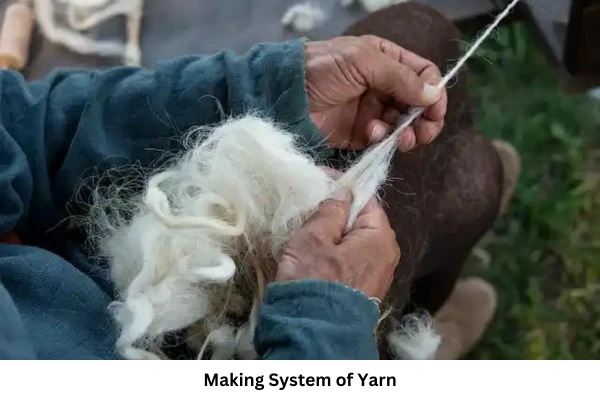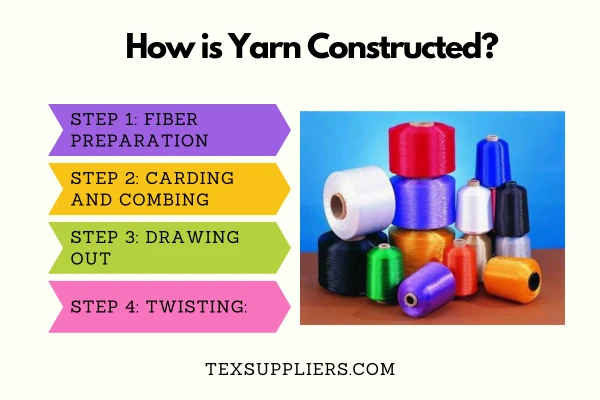While goofing around the many different yarns on the internet, you must get stumbled between “Spun” and “Synthetic Yarns.” Yarn, being the core ingredient, rules the textile industry through stitching, weaving, and knitting production. The article will revolve around the yarn’s meaning, its making, and various practices across the clothing industry.
Table Of Contents
What do we mean by Yarn?
In simple words, Yarn is an interlocked continuous length of fibers. The production of fabrics-crocheting and embroidery cannot be well-constructed without the help of yarns. It is thread tools that are usable for cloth making.

On the other hand, yarn consists of multifarious stranded materials that twist together and stay together. Each strand is shorter in length. These short fibers get spun with a view to creating the yarn. Sometimes, texturing is an additional process where yarns go into to get twisted.
What is Yarn Made of?
The yarn is a stranded fiber or filament. Fiber refers to the small and short hair piece. The yarn consists of both natural fibers and synthetic materials.

Natural fibers include sheep wool, silkworms, cotton, and linen whereas Synthetic fibers are man-made. Synthetic fibers include a variety of substances including nylon, polyester, and acrylic. So, yarn is composed form of plant fiber and animal fiber.
Different Forms of Yarn
There are several forms of yarn including:
- Cotton Yarn
- Blended Yarn
- Mercerized Yarn
- Spandex Yarn
- Polyester Yarn
- Nylon Yarn
- Viscose Yarn
- Textured Yarn
How is Yarn Constructed?
The Spinning process (The last process) of yarn making is machine-completed or sometimes hand-made. Yarn is a creation of several filaments spinning together. Depending on the fiber sources, the yarn gets produced in different processes. Natural fibers are spun in nature. Examples can be the cashmere or the wool from the sheep, the angora from the goats, and none other than the cotton from the cotton plant.

Apart from the production of textile yarn from natural sources. There is a synthetical production of the textile yarn. Because of their synthetic nature, they are human created. Synthetic materials, for instance, polyester nylon, and acrylic get created in the spinning dope. Here, the spinning dope tends to get pressed in a spinneret machine.
There are other several steps for instance:
Step 1: Fiber Preparation: Fibers get opened by machine or hand and shipped in a bales-like thing. Natural fibers require a cleaning process. Meanwhile, the synthetic fibers require only separating. Blending is the included process in this section for certain applications.
Step 2: Carding and Combing/ The Creation of Silver fiber mass: This carding machine separates fibers and put them in parallel form. After that, there is a formation of a thin fiber web. In the combing stage, fibers get transferred into a short-length parallel form.
Step 3: Drawing out: After the previous steps, fibers are well-known as silver. Carded silvers are twice and combed silvers are once drawn after each stage.
Step 4: Twisting: Here, the roving frame is the place where the fiber strands get elongated and provided necessary twists.
Properties of Yarn
|
Name |
Yarn |
|
Manufacturing Materials |
Natural and Synthetic fibers |
|
Fabric Piles |
One or More one |
|
Manufacturing Process |
Spinning or hand-made |
|
Fabric Elongation and Strength |
Less in number |
Characteristics of Yarn
Based on the fabric handle, aesthetic, performance, and convenient sensorial properties, yarns have a significant impact on the fabric parameters. For sewing threads, these features are important for yarn to be get characterized. These are:
- Continuousness: To sew smooth-like fabrics, there is none other than regular yarns. Keeping the regularity becomes easier when yarn gets doubled and drafted.
- Robustness and Hardness: The fiber consistency determines the yarn strength. Folding tries to increase the strength of the fabric. However, the thread hardness gets influenced by twist density.
Application of Yarn
The use of yarn is for making towels, dish draining pads, hot plates, and more chores in the kitchen. For daily wear, yarn is what we mostly depend on. Any type of fabric or materials handbags have these common applications. Among them, shawls, scarves, jackets, stockings, and shorts are popular ones. Other than these, there are furniture or home products that are mostly yarn-made. For instance: mattresses, pillows, curtains, and any soft like item.
FAQs
Are all yarns thread?
No, all yarn is no thread.
What are the main types of yarn?
Yarn types range from staple yarn to filament yarn mostly. But there are ply yarns and other types of yarns based on their unique applicability and features.
Final Words
Yarn is a natural or synthetic fiber-made material strand. In clothing, there is a process named spinning that creates yarn. The yarn has the most uses in the weaving and knitting processes. Yarns are popular for their strength, regularity, and hardness. We apply different types of yarn daily depending on their contrasts and power.
















Comments - 00
Leave A Reply
Thanks for choosing to leave a comment.